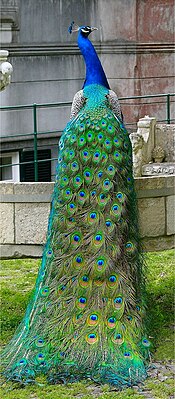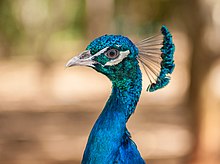Blue peacock
| Blue peacock | ||||||||
|---|---|---|---|---|---|---|---|---|

Peacock ( Pavo cristatus ), ♂ |
||||||||
| Systematics | ||||||||
|
||||||||
| Scientific name | ||||||||
| Pavo cristatus | ||||||||
| Linnaeus , 1758 |
The Blue Peacock ( Pavo cristatus ) is a bird art from the family of pheasant-like (Phasianidae). It belongs to the order of the chicken and is one of the best known representatives of this group of birds , along with the pheasant and the domestic fowl .
Because of their striking appearance, the males in particular are considered to be the oldest ornamental birds. They were already mentioned in the sagas of ancient Greece . As birds that are true to their location, the animals originally native to India and Sri Lanka are now kept as pets worldwide.
Appearance

The rooster is bright blue on the neck, chest and belly. Depending on the incidence of light, the plumage can shimmer greenish and golden. A narrow band that extends from the nostrils to the eye and a wide, semi-oval area under the eye is white and bare. In relation to the body, the head is rather small.
The train of the males consists of very elongated, one to one and a half meters long upper tail cover feathers . These can be set up to form a fan-shaped wheel. The vividly glowing pen drawing of large, blue iridescent " eyes " is intended to deter predators, who should interpret them as the eyes of large mammals. If this is not enough to drive an attacker to flight, the rooster sets the fanned tail feathers in a loud rattling motion. The actual tail is much shorter at around 40 to 45 cm. It is brown and consists of multi-stage control springs .
The shimmer of the feather rays is achieved by a fine crystal-like structure that is built up in a grid. This surrounds the ends of the springs and is arranged in such a way that they reflect light at different angles , similar to shimmering soap bubbles or oil stains on puddles of water. The structures are made up of melanin and keratin . The rooster’s magnificent plumage with its eye-catching cover feathers is referred to as a visual ornament in behavioral biology and is more or less an indicator of its genetic fitness. Although the long train is generally more of a hindrance and causes a reduction in the ability to fly, according to the so-called handicap principle , this fact is an indication of healthy, viable offspring for the females when mating.
Both sexes wear a small crown of feathers on their head. The roosters are about two meters long with tail train and weigh four to six kilograms. Compared to the rooster, the hens are drawn smaller and much less conspicuous, their body length is only about one meter. They weigh between 2.7 and 4 kilograms. Their plumage is predominantly greenish-gray. The females are dragless.
Senses
The blue peacock has a well-developed sense of smell and hearing. He is also very vigilant and warns other animals of danger early on with his loud, piercing screams. In India the tones are interpreted as “minh-ao”, which means something like: “Rain is coming!” And in fact, his characteristic scream often sounds before storms .
distribution and habitat
The blue peacock originally comes from the Indian subcontinent . There he preferred to live in hilly terrain in the jungle , especially near water.
Some blue peacocks come to the fields in family groups in the morning and evening to look for food . Because blue peacocks eat young snakes , they are popular in parts of India and are tolerated in the localities. There they can become very trusting .
According to the International Union for Conservation of Nature and Natural Resources , the population of the blue peacock has recently declined, but the species is still considered to be “frequent” in parts of its range ", So that the blue peacock is classified as" not endangered ".
The first peacocks were brought to the Mediterranean region 4,000 years ago . Their meat was also very popular with the Egyptians , the Romans and in medieval Europe , where it was often served with strong spices. Since the peacock is true to its location, it is kept free in many parks .
Forms created during domestication are the black- winged peacock and the white peacock .
Predators
In addition to tigers and leopards, which are its natural enemies, the peacock was also popular as a meat supplier in its native India.
Flight ability
Despite their size and long tail, male peacocks can also fly, but neither far nor high. In the event of danger, they rise into the air, flee into the bushes or seek protection in a tree. They also spend the night in trees to be protected from predators.
Reproduction
Peacocks are polygamous birds. They live in smaller family groups, which consist of a rooster and several hens with their accompanying young birds. The breeding season is April to August depending on the region and the weather. During this time, each rooster gathers three to five hens. The peacock then chooses a territory to occupy and defend against other roosters. During the extensive courtship , the male peacock turns his wheel and presents his magnificent feather fan. In doing so, he repeatedly lets his feathers tremble, which produce a loud rustling noise. He turns his back on the hen several times as soon as she approaches him. This peculiar behavior is repeated until the hen lies down in front of the rooster and he mates her in chicken style (see Tretakt ).
Immediately after mating, the hens go about their hatching business and look for a suitable place to lay their eggs. They build their nests on the edge of the forest in thick undergrowth. A clutch usually consists of 4-6, maximum 8 eggs. The eggs of the peacock are light white to pale yellow in color. The hens incubate the eggs for about 28-30 days. The clutch is only left to eat and drink. The hatched chicks grow slowly and prefer to stay under the mother's tail. The young chicks have a light, isabel-brown nest or down coat. Their plumage is slightly darker on top. After a month, the chicks get their crown. As young birds, the male peacocks are colored similarly to the female peacocks. At the age of three the males get their shiny plumage and the magnificent train, the full length of which is only reached at the age of six. They reach sexual maturity after 2–3 years .
Related species
A second species of the genus , the green peacock ( Pavo muticus ), occurs in Southeast Asia . The two species can be crossed with each other. The Congo peacock ( Afropavo congensis ) from Central Africa is also related .
Color variants and hybrids
The Schwarzflügelpfau ( Pavo cristatus mut. Nigripennis) is a through mutation resulting rendition of blue Indian peacock ( Pavo cristatus ). It can be crossed with the green or eared peacock ( Pavo muticus ). The so-called spaulding or spalding is created. The original "Spalding" was a cross between a female black-winged peacock and a male specimen of a green peacock. In the western world, peacocks are a welcome eye-catcher in many zoological gardens, parks and other extensive green spaces. Increasingly, private individuals and animal lovers are also discovering the bird as a pet , as it can be kept without confirmation of registration. But it needs a lot of free running. There is also an incentive for aviculturists to breed artificial mutations. This is especially popular in the US . There are a number of different mutations, such as
- White peacock ( Pavo cristatus mut.alba)
- Bronze peacock ( Pavo cristatus mut. Bronze)
- Black- winged peacock ( Pavo cristatus mut.nigripennis)
- Midnight peacock ( Pavo cristatus mut.nigripennis & mut.midnight)
- Black-winged peacock piebald ( Pavo cristatus mut.nigripennis & mut. Pied)
- Oat peacock ( Pavo cristatus mut.oaten)
- Opal peacock ( Pavo cristatus mut.opal)
- Blue pied peacock ( Pavo cristatus mut.pied)
The white peacock is often mistaken for an albino , but this is not albinism but leucism , which is why its iris is dark and not red.
Peacocks in Religion and Mythology
The peacock as a symbol of beauty, wealth, royalty, pride, love and passion, but also of immortality, arrogance and vanity, has always had a special place in the animal kingdom. Myths and legends from various cultures and epochs have grown up around him . In India , besides being a sacred animal, it is also the national bird . The Mayuri vina is a North Indian string instrument with a peacock-shaped body. In Kurdish Jezidism , the animal represents the "angel peacock", holy for the Yazidis , who is called Tausi Melek and who was appointed by God to be the supreme angel and protector and administrator of the earth. In the Sufi history of Fariduddin Attar's Birds Conference , the peacock (as " Gabriel " among the birds who made friends with the snake in the Garden of Eden ) also plays a prominent role. In Greek mythology , the goddess Hera created the peacock's “hundred-eyed” plumage from the many-eyed giant Argos , who guarded Io with his Argus eyes and was finally killed by Hermes .
For Persian poets, the peacock symbolizes beauty and pride, but also their imperfection, as shown in the unsightly feet and the limited flight ability of the beautiful and proud animal. In Islam , these animals are considered extremely clean and pure. In the 13th century, the poet Saadi considered only the peacock feather worthy of being a bookmark in the Koran in his work Golestan ("Rose Garden") . Goethe adopted this motif in the West-Eastern Divan and gave the peacock feather a divine being.
Symbolic representations of the peacock
The former British colonial flag of Burma (now Myanmar) graced the bird 1939–1941 and 1945–1948, as well as the current presidential flag . The bird is also used as a company logo, for example by the National Broadcasting Company and SriLankan Airlines .
The peacock in city and municipal coats of arms
The peacock in the coat of arms of the city of Neuwied and some local communities in the Neuwied district indicates the former Wiedsche state sovereignty .
- City of Neuwied
- Local church Steimel
- More about the peacock as heraldic animal
literature
- Josef Bergmann (1980): The Peafowl of the world . ISBN 0-904558-51-7
- Ernst Thomas Reimbold (1983): The peacock, mythology and symbolism . - Munich: Callwey. ISBN 3-7667-0682-9
Web links
- Pfauenforum with "dictionary" and pictures
- Pavo cristatus in the endangered Red List species the IUCN 2008. Posted by: BirdLife International, 2008. Accessed on December 18 of 2008.
- Videos, photos and sound recordings of Pavo cristatus in the Internet Bird Collection
- Feathers of the peacock
Individual evidence
- ^ Karl Schlamminger, Peter Lamborn Wilson : Weaver of Tales. Persian Picture Rugs / Persian tapestries. Linked myths. Callwey, Munich 1980, ISBN 3-7667-0532-6 , S, 144 f. ( The peacock ).
- ^ Karl Schlamminger, Peter Lamborn Wilson (1980), p. 145.
- ↑ Philipp Wolff (transl.): Sadi's rose garden. Stuttgart 1841, p. 175.
- ^ Goethe: West-Eastern Divan. In: Works. Volume 5, Stuttgart 1828, p. 227 ( at Google Books ).












